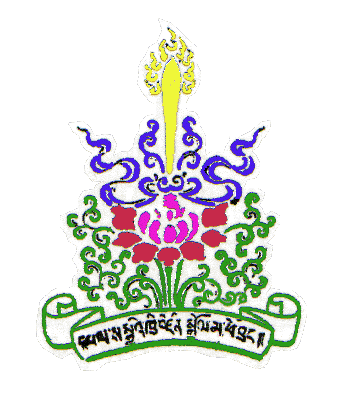A BRIEF HISTORY OF THE SAKYA TRADITION
by H.H. Sakya Trizin
|
The five great masters known as 'Gongma Nga' (the Five Exalted Ones) hold a special place in the annals of the Sakya Tradition. Sachen Kunga Nyingpo (1092-1158), the first Gongma, was the son of Khon Konchok Gyalpo. Through his efforts, hundreds of sutras and tantras, as well as oral instructions, were gathered and they became the basis for the Sakya canon. Thus the new school was firmly established as a distinct tradition with a philosophical system of its own. Lobpon Sonam Tsemo (1142-1182) and Jetsun Dakpa Gyaltsen (1147-1216) succeeded him as the fourth and fifth patriarchs of the Sakya school, and greatly enhanced the school through their meditation, their writings, and their demonstration of Dharma. The Fourth Gongma and sixth patriarch of the Sakya order, popularly known as Sakya Pandita (1182-1251), was the most famous of all. The fame of his knowledge and scholasticism spread as far as Mongolia and China, from where he received invitations from the imperial court. His nephew, Chogyal Phakpa (1235-1280), succeeded him as the Fifth Gongma and seventh patriarch of the Sakya school. During his time, the Sakya Tradition reached its political zenith, with the introduction of Mahayana Buddhism into China and Mongolia. The Mongol ruler Kublai Khan, in devotion, offered the thirteen myriarchies of Tibet to Chogyal Phakpa, and thus Tibet was united under a joint spiritual and political authority. These five masters - known to the Tibetans as 'Jetsun Gongma Nga' - are regarded as the real founders of the Sakya Tradition. |
|
Hundreds of Indian sutras and tantric teachings were assimilated into the spiritual life of Tibet through the efforts of the founders of the Sakya Tradition. The most famous of these are: the Hevaira Tanctras, whose transmission originated with the Mahasiddha Virupa, the Vajrakila Tantras of Padmasambhava, the Vairayogini precepts of Naropa, the Guhyasamaja Tantra teachings of Nagarjuna, and the Mahakala precepts of Vararuci. The distinct philosophical system taught by the Sakya school is known as the Lamdre, 'the Path and its Fruit', and is based on the Hevaira Tantra. These instructions originated with the Mahasiddha Virupa and had been brought to Tibet by the yogin Gayadhara, the teacher of Drokmi the Translator. The special philosophical view of the Sakya school is called the 'Non-differentiation of Samsara and Nirvana' and posits a 'Non-dual luminosity- emptiness' beyond all extremes. In terms of spiritual training, the Sakya masters have always stressed study and meditation in like measure; this ideal, so often embodied in the l*es of its eminent teachers, has won respect for the Sakya Tradition as one not only of learned scholars but of enlightened sages. The Sakya Tradition has the distinction of having a close connection with the other three major schools of Tibetan Buddhism. The Vajrakila lineage, which the Sakyapas follow, originates from Guru Padmasambhava, the founding master of the Nyingma school. The Kagyu and the Sakya schools originated almost at the same time, and both received important lineages from Naropa: the Sakyas follow the Vajrayogini of Naropa. Lama Tsongkhapa, the founder of the Gelug school, studied under many Sakya lamas, including Rendawa Shonnu Lodo, who was one of his most influential teachers. For the past 900 years, the adherents of the Sakya Tradition have preserved, studied, expounded and disseminated their unique tradition. In addition to this, over the centuries, the followers of the other schools of Tibetan Buddhism have also diligently studied Sakya philosophical and ethical teachings. H.H. Sakya Trizin Raipur, India |
[Related links] [Back]
 The Sakya Tradition originated in the eleventh century, and has been
closely connected with one of the 'holy families' of Tibet, the Khon
Family, since early times. One of the family members, Khon Lui Wangpo
Sungwa, became a disciple of the great Indian saint Padmasambhava in
the eighth century, being amongst the first seven monks to be ordained
in Tibet. Through the next thirteen generations, the Khon family was an
acknowledged pillar of the 'early propagation' in Tibet. However, it
was Khon Konchok Gyalpo who, in 1073, built Sakya monastery and thereby
established the foundations of the Sakya Tradition in Tibet. He studied
under Drokmi the Translator (992-1072) and soon became a master of many
deep teachings. The next two centuries saw the rise of the Sakya
Tradition to great heights, not only as a pre-eminent spiritual centre
but also as a political power in Tibet.
The Sakya Tradition originated in the eleventh century, and has been
closely connected with one of the 'holy families' of Tibet, the Khon
Family, since early times. One of the family members, Khon Lui Wangpo
Sungwa, became a disciple of the great Indian saint Padmasambhava in
the eighth century, being amongst the first seven monks to be ordained
in Tibet. Through the next thirteen generations, the Khon family was an
acknowledged pillar of the 'early propagation' in Tibet. However, it
was Khon Konchok Gyalpo who, in 1073, built Sakya monastery and thereby
established the foundations of the Sakya Tradition in Tibet. He studied
under Drokmi the Translator (992-1072) and soon became a master of many
deep teachings. The next two centuries saw the rise of the Sakya
Tradition to great heights, not only as a pre-eminent spiritual centre
but also as a political power in Tibet.